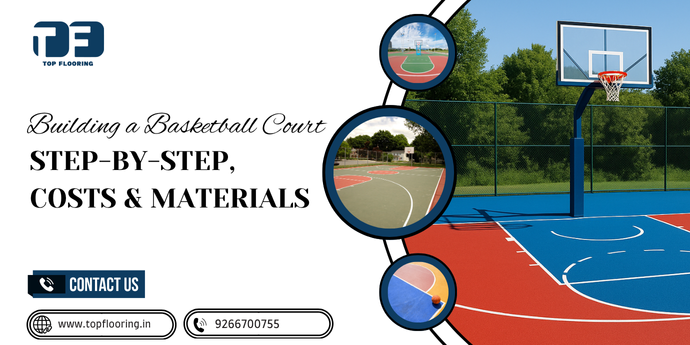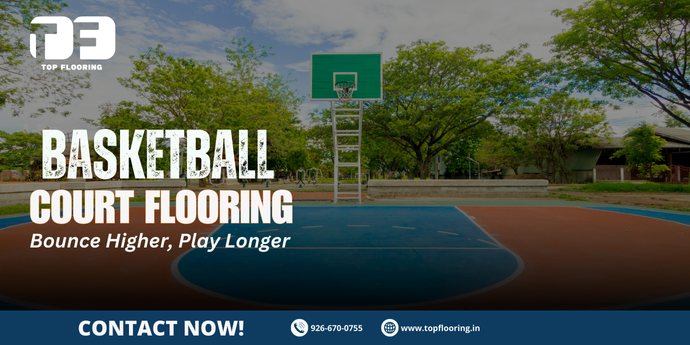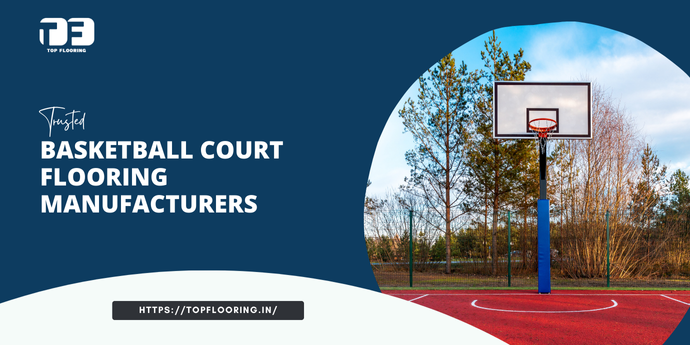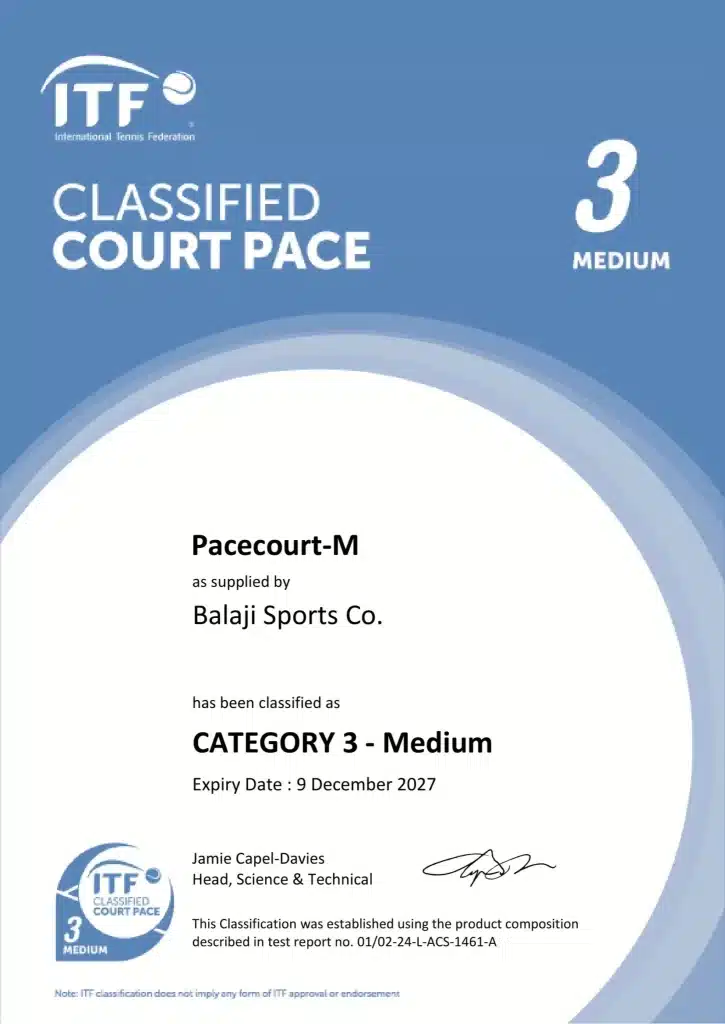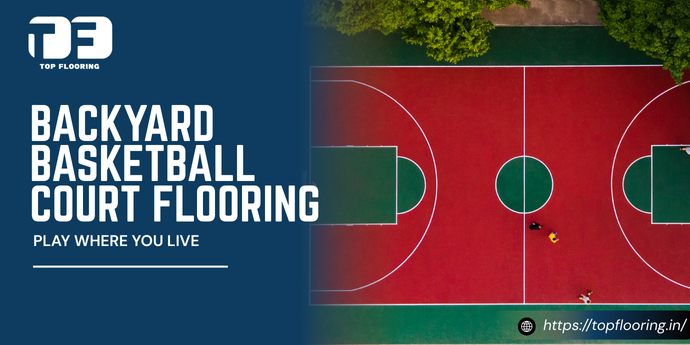
Imagine going out of your back door and shooting hoops on your own personal basketball court. Not waiting for a public court to free up, no membership fees, and no commuting, just good convenience, fitness, and fun in your own backyard. Backyard basketball court flooring is no longer a luxury reserved for athletes and sports clubs. Today, many homeowners are investing in personalized courts to encourage fitness, family time, and skill development. Whether you’re a parent looking to give your kids a safe playing space or an enthusiast who wants to stay sharp, building a backyard basketball court flooring is an investment that can transform your outdoor space.
This guide dives into everything you need to know from choosing the best backyard basketball court surface and planning the backyard basketball court construction, to estimating the cost to build a basketball court in the backyard, and maintaining your court for years of play.
Why Build a Backyard Basketball Court?
Building a backyard basketball court is more than just a home improvement project. It’s an investment in lifestyle, health and family bonding. A professionally installed backyard basketball court surface turns unused outdoor space into a personal playground. Where you can play whenever you want. There is no need to wait for a public court to open up. Your own court gives you the freedom to practice, shoot hoops or play a full game with friends whenever you like. This is one of the biggest reasons homeowners are installing backyard basketball courts.
Beyond convenience a home basketball court becomes the hub of family activity. Kids can spend hours outside developing coordination and teamwork. Parents can join a game and create lasting memories. Basketball is a great workout and having a dedicated basketball floor for the backyard encourages daily movement, reduces screen time and promotes a healthier lifestyle for everyone. And a well constructed backyard basketball court flooring system can increase property value and make your home stand out.
Backyard Basketball Court Planning
Before choosing the right backyard basketball court material or hiring contractor. Planning of the basketball court is key to a successful project. A well-planned approach means your court fits the space, follows local regulations and is safe and functional for years to come. Here’s what to focus on:
1. Space
Start by measuring how much space you have for your court. A full size basketball court is 94 × 50 feet (NBA standard). And a half basketball court 47 × 50 feet is perfect for most residential backyards. For smaller properties a 30 × 30 feet basketball court can work beautifully to allow for casual play and skill building drills. Even a small half basketball court can provide endless playing opportunities so don’t be limited by space. Just make sure there’s enough room around the playing area for safety zones, fencing and maybe some landscaping to keep the area safe and looking good.
2. Site Selection and Preparation
Next select the location within your property. Choose a flat area that gets good sunlight throughout the day and has natural drainage to prevent water from accumulating on the court. Before you start any backyard basketball court construction, clear the area of obstacles such as trees, rocks or old structures. Proper grading and leveling of the ground is crucial to create a stable base that won’t crack or shift over time. Don’t skip this step or you’ll compromise the whole project so take the time to prepare the site properly.
3. Local Permits and HOA Rules
Before you start your basketball court installation backyard project check all local regulations. Many municipalities and housing societies have specific zoning laws, building codes or homeowners’ association (HOA) rules that govern permanent sports structures. You may need to submit a simple site plan or get approval before you start. Taking care of permits early means your project complies with the law and helps you avoid delays, penalties or having to tear out your court later.
Backyard Basketball Court Surface
The backyard basketball court surface you choose will determine court performance, its durability and maintenance it will need over the time. Choosing the right basketball court material means consistent ball bounce, player safety and weather resistance. Here are the most popular and reliable options for backyard basketball installation.
1. Acrylic Sports Flooring (Multi-Layer System)
Acrylic sports flooring is made by applying several layers of acrylic coatings over a concrete or asphalt base. Sometimes with optional cushion layers for shock absorption. This system creates a durable, non-slip, and vibrant playing surface that performs well in all weather conditions. The textured finish provides excellent grip and consistent ball bounce, perfect for intense gameplay. This is the best surface for a backyard basketball court. Because it offers best performance at an affordable price with low maintenance.
2. Modular PP Tiles
Modular polypropylene (PP) tiles are interlocking panels that can be installed over any flat and stable base, with water drainage. These tiles are quick to install, easy to replace and have good traction with built-in shock absorption. They can be detached and moved, perfect for families or renters. It may fade slightly under prolonged sun exposure. But modular tiles are a DIY friendly solution for backyard basketball flooring that still delivers good play quality.
3. Concrete or Asphalt Base with Color Coating
This surface involves pouring a concrete or asphalt slab and then painting it with sport court coatings and line markings to create a playable finish. It’s one of the most durable and long lasting backyard basketball court flooring options, and can handle heavy use with minimal wear. Upfront cost is low, perfect for homeowners on a budget who want a strong and permanent surface. But it has less shock absorption and requires proper installation to avoid cracks that can affect bounce and safety over time.
4. Wooden Flooring (for Covered Courts)
Wooden flooring is usually for covered or enclosed backyard courts as it’s sensitive to moisture and weather. It offers unmatched aesthetics and superior ball bounce, giving the court an indoor, pro-level feel. This type of backyard basketball court surface is more expensive and requires climate control to prevent warping or swelling. It’s a premium option for luxury projects where style and performance is top priority under a weather-protected structure.
How to choose the Best Material for Backyard Basketball Court
When building your backyard basketball court, one of the biggest decisions is the surface. The backyard basketball court material will affect the performance, longevity and maintenance of the court over time. Weigh your options carefully – weather resistance, maintenance, cost and play comfort.
Weather Resistance
Weather resistance is key because outdoor courts are exposed to the elements 24/7. Materials like synthetic acrylic flooring and modular PP tiles are designed to withstand India’s heat, heavy rains and harsh UV rays without cracking or fading. They retain their color and texture even in extreme conditions. So your backyard basketball court surface looks and feels good all year round. A weather resistant surface protects your investment and reduces repair cost of basketball court.
Maintenance Needs
Another important factor is how much it will cost for basketball court maintenance. Surfaces like acrylic flooring need to be recoated every 5-7 years to refresh the grip and color. While modular tiles need individual pieces replaced if damaged. But both are easy to clean with a broom and water, unlike wooden floors that need climate controlled storage. Thinking about maintenance early helps you choose a backyard basketball court material that fits your lifestyle and prevents long term maintenance from affecting play quality.
Backyard Basketball Court Budget
Budget plays a big role in any backyard basketball court installation project. Concrete slabs are the cheapest option, initially a hard durable base for a low cost. But investing a bit more in acrylic or tile based systems will give you much better long term value as they resist cracking, fading and weather damage for years with minimal maintenance. Balancing your upfront cost with long term performance ensures the cost to build a basketball court in the backyard stays within your budget without compromising on quality.
Play Comfort
Finally prioritize playing comfort to prevent joint fatigue and injuries, especially if the court will be used frequently. Acrylic systems can have cushion layers that absorb impact, while PP modular tiles have built in flex that reduces stress on knees and ankles. This makes playing on your basketball floor in the backyard much safer and more enjoyable, especially for kids and older players. A comfortable surface keeps players active longer and encourages regular use of your home court.
The Backyard Basketball Court Installation Process
Once you’ve chosen your backyard basketball court surface, it’s time to start the actual backyard basketball court construction. A well planned and executed build ensures the court stays durable, safe and playable for years. Here’s a step by step look at the backyard basketball court installation process:
1. Base Construction
The first step is to lay a solid and level base for your backyard basketball court flooring. This starts with digging the area and removing grass, rocks or loose soil until you hit a stable subgrade. Once cleared, a compacted stone sub-base is laid down to provide structural support and prevent the surface from shifting or cracking over time. Then a reinforced concrete or asphalt slab of at least 4 inches thick is poured and allowed to cure fully to reach its maximum strength. Also make sure to create a 1% slope across the base so water can drain off and not puddle on your backyard basketball court surface.
2. Surface Preparation
Once the base is cured, the chosen backyard basketball court material is installed to create the playing surface. If you’re going for acrylic systems, the contractor will apply a primer, then a resurfacer to smooth out imperfections, then several cushion coats for shock absorption, color coats and finally line markings. For modular PP tiles, the tiles are laid out and interlocked over the concrete base to create a uniform impact resistant playing area. If you’re going for painted concrete, specialized sport coatings are rolled or sprayed on the slab and game lines are marked to define the court layout. Each method requires expert application to get a durable and high performing backyard basketball court.
3. Equipment Addons
Once the surface is ready, the next phase is to add the game equipment. Heavy duty basketball hoop poles are anchored into the ground and professional backboards and rims are mounted at regulation height to complete the setup. Around the court’s perimeter, fencing or netting can be added to keep balls from going out and to create a safer play area especially if space is limited. Finally outdoor LED lighting is installed so you can use the court in the evenings or cloudy days, extending its use. These elements turn your project from a flat surface into a fully functional backyard basketball court space.
Cost to Build a Backyard Basketball Court
Understanding the cost to build a backyard basketball court is crucial for planning. Prices vary based on size, material, and location. The table below breaks it down step by step:
| Category | Details | Estimated Cost |
| Material Costs | Concrete Base | ₹250–₹400 per sq. ft |
| Acrylic Surface System (multi-layer) | ₹180–₹300 per sq. ft | |
| Modular PP Tiles | ₹250–₹350 per sq. ft | |
| Sport Line Markings & Paint | ₹15–₹30 per sq. ft | |
| Installation Costs | Professional backyard basketball court installation cost adds 30–50% to material cost, including base preparation, labor, curing, surfacing, painting, and quality checks. | Variable |
| Total Estimated Cost by Court Size | Compact (30×30 ft) | ₹3.5–₹5.5 lakhs |
| Half-Court (47×50 ft) | ₹7–₹11 lakhs | |
| Full-Court (94×50 ft) | ₹14–₹22 lakhs | |
| Additional Budget | Fencing, Lighting, Landscaping (Recommended) | Add 10–15% to total |
Choosing premium backyard basketball court material like acrylic coatings will increase upfront cost but provide better performance, longer durability, and lower maintenance over time.
Backyard Basketball Flooring Maintenance Tips
Once your court is installed, proper maintenance is key to extending its life. Good maintenance keeps your backyard basketball flooring safe, looking good and performing well for years to come. Start with regular sweeping to remove dirt, leaves and debris that can make the surface slippery or scratch the coatings. A clean surface has good traction and reduces wear. Every month or two wash the backyard basketball court surface with a mild soap solution and a soft-bristle brush to remove stains, algae or buildup from rainwater.
Regular inspections are just as important. Check for cracks, bubbling or peeling on the surface especially after harsh weather. If you see any damage, schedule spot repairs immediately to prevent it from spreading. For acrylic coated courts, plan to resurface or reapply topcoats every 5-7 years depending on usage. This keeps the colors bright and the bounce consistent. Don’t drag furniture, ladders or heavy equipment across the court as this can scratch or damage the coating. With these simple practices your backyard basketball installation will be safe, looking good and ready for play season after season.

Why Hire Professional Court Builders Like Top Flooring
Building a backyard basketball court is a big investment and the quality of the construction will determine how long it will last and how well it will perform. While DIY installations may seem cost effective at first glance, they often fall short on durability, safety and finish. Hiring experienced professionals like Top Flooring means your backyard basketball installation is done with precision, expertise and the right materials from the ground up.
Top Flooring’s team knows the technical aspects of backyard basketball construction — from grading and compacting the soil base to pouring a level concrete slab and installing surface systems with perfect alignment. They use premium backyard basketball material designed for outdoor weather conditions, slip-resistance, UV protection and superior impact absorption. This creates a safe and comfortable playing surface that delivers consistent ball bounce and minimizes the risk of injuries, hard to achieve with a DIY approach.
One of the big advantages of working with Top Flooring is they pay attention to the details that homeowners often overlook, such as drainage systems to prevent waterlogging, allowing the concrete base to cure properly to prevent cracking and accurate line markings to give your court a professional look. They also offer end to end project management, permits, equipment setup and finishing touches like fencing or lighting — so you get your backyard basketball installation all in one place without the hassle of dealing with multiple contractors.
Design Ideas to Make Your Backyard Basketball Court
Your court doesn’t have to be boring. Here are some ways to make your backyard basketball court stand out and be you:
Custom Court Colors
Instead of sticking to black or gray, personalize your court with team colors, geometric patterns or your favorite sports team theme. Many installers can also add logos, initials or custom graphics into the surface coating. This makes your backyard basketball flooring look professional and tournament like. It turns your court from a basic play area into a showpiece of your backyard.
Multi-Sport Lines:
If you want to get the most out of your outdoor space, consider adding lines for multiple sports like badminton, volleyball or pickleball along with your basketball lines. This turns your basketball court installation backyard into a multi purpose recreation area for the whole family. The extra lines can be painted in contrasting colors so they’re visible but don’t interfere with basketball play. It’s a smart way to get your money’s worth.
Landscaping:
Surround your court with greenery to soften the hard playing surface and create a nice environment for players and spectators. You can install artificial turf borders, planters or even shaded seating areas around the backyard basketball court zone. Well thought out landscaping adds comfort, aesthetics and makes your court blend in with your outdoor space instead of standing out like a slab of concrete.
Lighting:
If you want to use your court at night, you need to install LED floodlights. Modern outdoor sports lights are energy efficient, weatherproof and provide bright even lighting across the entire backyard basketball court. With good lighting you can host evening games, weekend tournaments or casual family games without being limited by daylight. It makes your court usable year round and extends the hours of fun.
Court Fencing:
Safety fencing or perimeter netting is a practical and stylish addition to your backyard basketball court. It keeps balls from bouncing into neighboring yards or damaging surrounding property and also player safety. Choose mesh fences or transparent sports netting that matches your landscaping. Besides function, fencing creates a boundary for the court and makes it feel like a professional playing arena.
These design elements turn a basic backyard basketball court into a showpiece that increases the visual appeal, functionality and fun of your outdoor space.
Common Mistakes to Avoid During Backyard Court Installation
Even with the best of intentions, many homeowners make big mistakes during backyard basketball court installation that cost them big time. One of the biggest errors is not preparing the base properly. A poorly compacted or uneven base will crack and ruin the surface no matter how good the backyard basketball court material is. Not having proper drainage can lead to water pooling which causes surface damage, algae growth and unsafe playing conditions.
Another mistake is using indoor materials like wood or laminate outdoors which will warp or degrade quickly under sun and rain. Homeowners sometimes choose the cheapest option and find out that the surface fades, peels or becomes slippery within a year. And sometimes they skip permits or don’t check the property regulations and end up in legal troubles and forced removal of the court. By avoiding these mistakes and going for professional backyard basketball court construction you ensure a durable, safe and high quality playing area that will last for years.
Conclusion
Building a backyard basketball court is one of the best ways to combine fitness, recreation and home value in one project. The key is to choose the best backyard basketball court surface, plan professional backyard basketball court construction and know the true cost to build a backyard basketball court before you start.
From vibrant acrylic coatings to modular tile systems, there are plenty of reliable backyard basketball court material options for all budgets. Although the backyard basketball court installation cost may seem high at first, it pays off with years of family fun, fitness and game time memories.
With the right approach you can turn an unused corner of your property into a personal sports haven. The bounce of the ball, the thrill of the game and the pride of owning your own court — all just steps from your back door.
Frequently Asked Questions
Measure the space and ensure level ground, construct a concrete or asphalt base, install a sports flooring system (multi-layer acrylic or modular tiles), fix the basketball hoop, paint playing lines, and optionally add lighting or fencing.
Most backyard courts range from compact 20×30 ft to half-court sizes around 30×50 ft. A full-size court is 94×50 ft, but homes generally choose a reduced half-court.
Typical cost ranges from ₹7–₹15 lakh in India (about $8,000–$20,000 globally), depending on size, base construction, flooring type, and add-ons like fencing or lights.
Absolutely. You can add extra line markings for tennis, volleyball, pickleball, or badminton, making your backyard court a multi-sport play area for your entire family.
Maintain your backyard basketball flooring by sweeping daily, washing monthly with mild soap, repairing cracks quickly, and planning resurfacing every 5–7 years to keep it safe and vibrant.

